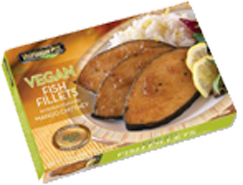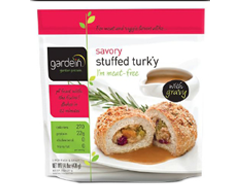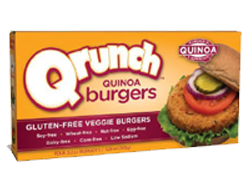Meat analogs used to offer one choice: Either you suffered, or the animal did. Today, processors are artisans at creating
meat, poultry and seafood substitutes so good they cluck, moo and…whatever it is fish do.
David Feder, RD, Managing Editor
F
ake meat—once almost exclusively from textured
soy—was typically mealy, and the taste tended to be
bland and garlicky, either serving as a placeholder
for a cover-up sauce or overwhelming everything in its
path. Neither could satisfy the craving for toothsomeness
or umami that (formerly) only came from animal protein.
Today, while most animal protein analogs are still made
from soy, ingredients such as mushrooms, nuts and grains
(i.e., almonds, amaranth, oats or quinoa), and even eggplant
are providing alternatives for meat that satisfy those
primordial protein cravings. Also, new technology in gums,
flavorants and sodium-replacers are making these trompes
l’papilles foolproof foolers.
According to Mintel Group Inc., “The future trends for
meat substitutes will focus on indulgence, health (as infortification and enrichment) and convenience. Low fat, high
protein, added vitamins and minerals, as well as omega-3
fish oils, vitamin B and iron-enrichment on meat-free products
will be the most important demands of the consumers.”
The research group also noted the increasingly positive
consumer reaction to “organic, eco-friendly and animal
welfare-related labels” on products.
“Many people want to decrease their overall meat consumption
for health, economic or environmental reasons,”
states Marie Osmunson, founder and CEO of Chez Marie
Inc., makers of vegetarian burgers. “They are the driving
force behind the growing ‘meat alternative’ category.”
From a business standpoint, this consumer demand translates
to more than $500 billion in annual meat analog sales.
Boca Foods Co., one of the original veggie burger-makers,
started in 1979 as Sun Burger and has been a subsidiary of
Kraft Foods Inc. for the past decade. The brand, by itself, has
sales of around $100 million per year.

Artful use of seaweed provides surprisingly authentic, yet
vegan-friendly, flavor and texture in ersatz salmon filets,
including very clever use of textured nori to replicate salmon skin.
The rapid increase in demand for vegetarian options was
fueled by a perfect storm of environmental, philosophical/
religious and, finally, food-safety considerations. This led
to a surge in consumer interest in meatless meals. This new
category of “sometimes vegetarians” (a.k.a., “flexitarians”)
hit like a tidal wave. Fortunately, food and ingredient technology
also reached a new level of artistry, allowing processors
to come up with not merely satisfactory substitutes, but
substitutes that truly satisfied.
With the fat stripped out of a powdered, high-protein
source, a combination of heat (about 300-400°F) and pressure
allows the product to be extruded into any number of
shapes and textures, from chunky to fibrous strands. But,
processors rarely did; instead, they used the more common
flakes, chunks and crumbles that could soak up triple their
gram weight in sauces or meat juice. Animal protein analogs
began as cheap extenders to lower the cost of meat in
institutional production or to serve the very small population
of vegetarians.
Flavor, texture, chew, cooking, contrast, umami, aroma—
all must come together perfectly to hit that “satisfaction”
factor. Kellogg Co.’s Morningstar Farms has been the
most advanced and adventurous pioneer in the field, able
for decades to successfully accomplish this, and across an
incredible range of offerings—burgers, sausages, meatballs,
hot dogs, chicken patties (breaded and grilled). Morningstar
products use a combination of tapioca starch, wheat and corn
gluten, plus cellulose, modified corn starch, maltodextrin
and lecithin as texturants and stabilizers.
While it’s the “Grande Dame” of the meatless meat world,
and can boast perfect pitch when it comes to fooling the
palate for taste and texture, Morningstar Farms is unusual
in that its products are not vegan. The company uses egg
protein and/or dairy derivatives, such as casein and whey, in
most of its products.
Also using dairy in some of its products (its burger is completely
vegetarian) is Dominex LC, a processor that takes
advantage of the natural umami characteristics of eggplant
to produce a line of vegetarian alternative products from
this “meaty” cousin of nightshade (Solanum melongena). Its
meatball surrogate includes skim milk and Parmesan cheese
for flavor. The combination of eggplant and soy protein, plus
native rice starch and methylcellulose, replicates the flavor
and textures of its designated delegates.
Something Fishy
Celebrating its 15th year, VegeUSA LLC has a greatly
expanded line of Vegetarian Plus branded meat and poultry
alternates. The company uses soybean fiber, as well as soy
protein, plus wheat protein and/or tapioca starch and other
modified starches. But, VegeUSA also dropped a line into
the waters of fake fish. Fish and seafood analogs are a trickier
proposition, because the textures and flavors are so very
different from land critters. However, smart use of fibers
and starches, plus egg whites and seaweed to give a slightly
gelatinous component identical to fish, adds the right flavornote,
resulting in something many consumers wish the real
swimmers had: a little less fishiness. The use of nori in the
fake salmon filets to replicate both the flavor and texture of
salmon skin is truly ingenious.
“Some vegetarians who try our products have commented
on the texture and say it’s different than the other vegetarian
‘meats’ they’ve tried,” admits Bethany Ugarte, product
manager for VegeUSA. “This is because most vegetarians
will eat dairy, so they can enjoy products with whey protein
in them. Whey will give a different texture—not good or not
bad, just different—to meat substitutes, in comparison to
wheat protein, which our products contain.”
Vegetarian Plus products use a base of soy protein, but,
acknowledges Ugarte, “Soy needs a binder, either wheat or
whey, and cannot stand alone. Since whey is dairy, we use
wheat to create our perfectly textured beef, chicken, pork,
fish, etc., items.” The difference in texture, not only taste,
reflects a great deal in not only what ingredients are used,
but the amount in which they are used, according to Ugarte.
“An item can have a different taste and texture with the
same ingredients, but different amounts of each ingredient.
In shrimp, konjac powder [an Asian sweet potato] is really
what makes the buoyancy so much like the real thing,” says
Ugarte. “If we used wheat or soy, the texture would just be
more of a land animal texture.”

Processors of animal protein analogs have upped their game
to include whole-meal starter kits that also mimic the level of
convenience consumers experience in the meat and poultry cases.
Yves Veggie Cuisine Inc. uses glucomannan, the polysaccharide
fiber extract of konjac, in its seafood analogs.
Its imitation shrimp also relies on potato starch and whey
protein to hit the right texture for shellfish. The company,
another imitation-meat pioneer, has been active since 1985, making pizza lovers happy by creating one of the first commercialized
meatless pepperoni products. It achieves the
right density with soy protein isolates, in conjunction with
wheat gluten and wheat starch.

Not being made from animals, once the sole criterion of a
meat analog, is becoming just one of multiple “made without”
ingredients, such as with Qrunch’s wheat-, soy-, dairy-, egg-,
nut- and gluten-free offerings.
Variety and Spice
The same Yves, Yves Potvin (who created the first veggie
hot dog back in the 1980s), today is the head of Garden
Protein International Inc., maker of Gardein foods. Gardein
products are made through a proprietary process with a
blend of slow-cooked soy, wheat and pea proteins, as well
as organic flour from high-protein ancient grains—kamut,
amaranth, millet and quinoa. The formulations also include
potato starch, modified vegetable gum, and organic beet
and carrot fibers. Starting 10 years ago with just a handful
of selections doubling for chicken and beef, the company
rapidly joined the front of the pack with multiple offerings
in both frozen and fresh formats, and featured an impressive
variety of “cuts.”
Gardein also attained the marketing coup of forming
strategic alliances with QSRs and a recent partnership with
Light Cuisine. Product development focuses on ethnic and
on-trend flavors, including such items as Korean-style BBQ,
Tuscan “chicken” breasts, chipotle lime-breaded “chicken”
strips, Buffalo wings, and marinara and Marsala offerings.
Variety allows processors of meat substitutes to appeal
to a wider consumer population. This variety extends not
only to the type of meat replicated but the offerings within
the categories of beef, chicken, poultry or seafood substitutes.
The leading companies making these products, such
as Gardein, Morningstar Farms and VegeUSA, have been
aggressive in developing and releasing new products in
multiple categories and for multiple uses. Everything from
breakfast sandwiches and wraps to sushi to pulled “pork”
and spare ribs have been filling shelves to serve as heatand-
eat meals, side components or meal-starters.
“VegeUSA makes sure every product is different from
the other,” says VegeUSA’s Ugarte. “Even our Ginger
Chicken and Kung Pao Chicken are different from each
other. In addition, we always pair our vegan meat with a
sauce designed especially for that item, to compliment
not just the flavor, but also the texture and profile we
are imitating.”
Lightlife Foods Inc. is another original presence in the
vegetarian meat-substitute field, entering its 35th year. The
maker of the original Tofu Pup soy hot dogs bases most of
its offerings on soy, vital wheat gluten and soy isolates. Its
products also include such mainstream texturants as carageenan,
and xanthan and guar gums, as well as the more singular, such as fermented rice flour. Hot
dogs, sausages and deli slice analogs have
been joined by imitation poultry cutlets,
burgers and frozen entrées.
Goodbye, Gluten
While soy is the orbital center for most
meatless offerings, followed closely by
wheat derivatives, especially gluten, a
backlash against both of these ingredients
has led some developers in a different
direction. The big breakthrough in nonsoy-,
non-wheat-based alternate proteins
can be said to belong to Quorn Foods
Inc. The company’s products are built
from mycoproteins—fungi. While fungus
is not the most appetizing word in food
production, in this case, the filamental
fungus, Fusarium venenatum, is similar to
any other edible fungus, i.e., mushroom.
(It should be noted that Quorn products
are made in facilities that produce
wheat ingredients, so even without gluten
sources in its formulations, the products
might not be suitable for persons with
celiac disease.)
For Quorn’s meat-replacement products,
mycoproteins make perfect sense,
when one considers the two ingredients
used to describe the concept of umami are
meat and mushrooms. Quorn starts with
a fermented Fusarium biomass that has
been grown in oxygenated water in sterile
tanks. Glucose is used to feed the cells,
and vitamins and minerals are added to
enrich its nutritional value. After extraction,
it’s heat-treated and dried. Egg white
is added as a binder, and trace amounts of
pea fiber also are added.
Another soy-less and wheat-less “Q”
launched recently was Qrunch (Qrunch
Foods LLC.). Non-triticale (wheat and
wheat-origin) grains are used as a base,
in this case quinoa (hence the “Q” in
“Qrunch”). Qrunch patties are not only
soy-free, they contain no corn, nuts, egg
or dairy. The primary ingredient actually is
millet, followed by quinoa. Depending on
the flavor variety, the formulation might
be boosted with legumes, such as pinto
beans. In addition to other vegetables for
flavor and texture, Qrunch patties use
arrowroot starch and psyllium seed powder.
Psyllium is rich in the insoluble fiber
mucilage, a highly hydrophilic molecule
that forms a viscous gel, making it
a favored texturant. Psyllium also is
a beneficial fiber for health, favored
for an ability to reduce cholesterol
and lower glycemic response.
Replacing soy and wheat can pose
challenges, as not all plant proteins
are alike. Hemp seed is being considered
by some manufacturers. In
fact, Chez Marie recently announced
it has such a product on the way. But,
the combination of unique texture
provided by soy and wheat makes
them hard to replace. Lupin beans have garnered some interest; however, more development is
needed, as the bean does not contain the same hydrophilic abilities
as soy proteins and fiber, making it less able to gel and stick
together.
While Sol Cuisine Inc.’s veggie burgers are not soy-free, its
developers brought almonds, lentils, spelt, amaranth and tapioca
into the mix. It also uses modified vegetable and xanthan gums
for texture and binding. The advantage of this approach is a higher
fiber content (6g per serving) than most of its competitors in the
vegetarian burger category.
In fact, the effort to cater to a more targeted population of
allergen avoiders and other focused consumers has led a number
of processors to change formulations to exclude eggs, dairy,
wheat and GMOs. A few even proclaim their lack of corn syrup.
Boca Burgers decided to go egg-free in 2009 and completed that
transition in 2011. Other companies are complying with various
certifications, switching to organic ingredients and even using
“gluten-free alternative” as a label declaration.
Source by www.preparedfoods.com